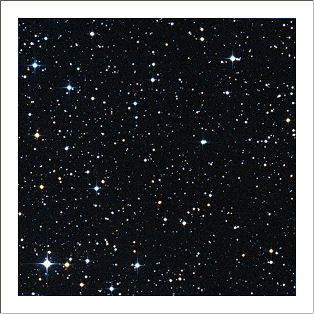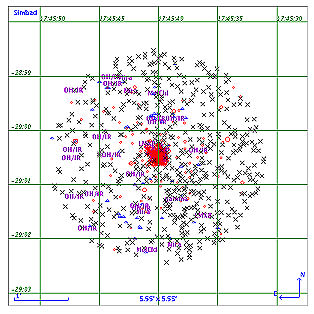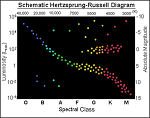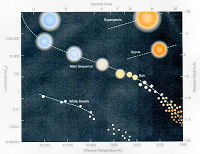§ Stars
A self-luminous celestial body consisting of a mass of gas held together by its own gravity in which the energy generated by nuclear reactions in the interior is balanced by the outflow of energy to the surface, and the inward-directed gravitational forces are balanced by the outward-directed gas and radiation pressures — Maynard F. Jordan Planetarium at the University of Maine
A ball of mostly hydrogen and helium gas that shines extremely brightly. Our Sun is a star. A star is so massive that its core is extremely dense and hot. At the high stellar core temperatures, atoms move so fast that they sometimes stick to other atoms when they collide with them, forming more massive atoms and releasing a great amount of energy. This process is known as nuclear fusion — Astronomy Picture of the Day Glossary
A star is a massive, luminous ball of plasma — Wikipedia
§ Contents
- You Should Know — Star Terminology & Information
In This Section You Should Know — Definitions from the Astronomical Science of Stars - Stars — Introduction
A Jeweled Pair — Albireo A & B - The Stellar Classification of Stars
The H-R Diagram — O, B, A, F, G, K, and M - History of the H-R Diagram
Amateur Astronomer: Ejnar Hertzsprung — Influential Astronomer: Henry Norris Russell - History of the H-R Diagram...continued
Amateur Astronomer: Ejnar Hertzsprung — Influential Astronomer: Henry Norris Russell - Evolution within an Evolving Universe
Evolution of the Universe & Universal Evolution — Stellar Evolution - Spectral Classification of Stars
Star HD 66171 — Spectral Classification, Counting Photons - The Luminosity Class
Luminosity class, A Star's Radius & Temperature — Apparent Magnitude - Sources & Further Study
Additional Resources - Star Types
Introduction to Star Types — Most of the Older Pages Displayed, Revisions in Progress
1. You Should Know — Star Terminology & Information
» On the Following Pages - is a brief tour of the most numerous objects in the stellar heavens, the Stars. We'll talk about spectral classification, absorption, luminosity, etymology, historical overview and visit stars both common and exotic — binaries, cepheids, protostars, white and brown dwarfs, nuetrons and pulsars. Most of the information is derived directly from the sources: scientific and educational institutions to professional and amateur astronomers and is presented in the form of references, images, formulas, fundamental constants, links and more. Following are some definitions you should be familiar with, arranged in the order of their appearence on the following pages:
» Arcmin/Arcminute - unit of angular measurement, equal to one sixtieth (1/60) of one degree. For example, when viewed from your backyard the full Moon appears to have a diameter of 30 arcminutes.
» Star Name - Some stars are designated by a proper name, such as Sirus or Betelgeuse but many are referred to simply by a catalogue number, and to some this may appear to resemble a phone number complete with area and country code as in CXOGC J174540.0-290031 which is the designation of a low mass binary star. Other examples of star designations you are going to find here include: HD 16545 | HIC 12478 | HIP 12478 | SAO 38212 | TYC 2857-1664-1 | PPM 45328. All these letters and numbers refer to the same star but are from different catalogs: HD for the Henry Draper Catalogue, HIC for stars recorded in the Hipparcos Input Catalog used for planned Hipparcos mission, HIP for the Hipparcos catalogue which was compiled by the European Space Agency (ESA) from data obtained from their astrometric satellite Hipparcos, SAO for the Smithsonian Astrophysical Observatory Star Catalog, TYC is another catalog from the ESA which uses the Guide Star Catalog (GSC) numbering system and PPM 45328 for the Postion and Proper Motion Star Catalogue.
» Galactic Center - the rotational center of our Milky Way galaxy, located about 24,800ly away from the Earth, in the direction of the constellation Sagittarius.
» Simbad - an astronomical database providing basic data, cross-identifications, bibliography and measurements for astronomical objects outside the solar system. Simbad Website
» Aladin - is an interactive software sky atlas allowing the user to visualize digitized astronomical images, superimpose entries from astronomical catalogues or databases, and interactively access related data and information from the Simbad database, the VizieR service and other archives for all known sources in the field. Aladin Website
» Spectral Type - a classification system for stars based on an analysis of the light they emit.
» Hertzsprung-Russell Diagram - in it's most simple form this is a diagram mapping a star's brightness against its temperature.
» Absolute Magnitude - is the brightness of any particular star if viewed from a distance of 32.6 light-years or 10 parsecs from the observer. Absolute magnitude takes into account the distance of a star using a standard formula. The formula used in calculating the relationship of magnitude and distance is expressed as:
m = M + 5 - 5 log d Where m is the star's apparent magnitude, M it's absolute magnitude and d is the star's distance in parsecs. The logarithm is the common base 10 log.
» Apparent or Visual Magnitude - is the degree of brightness in the visible spectrum which you can see with your eye. The system of star magnitude is structrured so that the smaller the number the brighter the star. It's formula also states that a magnitude 1 star is 100 times brighter than a magnitude 6 star which is just visible to the unaided eye. Some of the darkest stars nearby have magnitudes as large as 16 with the brightest star, Sirius, having a visual magnitude of —1.43. The formula used defines the magnitude as the logarithm of the flux or power per unit of area received from a star and is expressed as: Ma - Mb = —2.5 log( Fa/Fb ) where M is the magnitude of star a & b and F the flux of each star.
» Luminosity (L ) - a measure of the total amount of energy radiated by a star or other celestial object per second or the power output of a star. Astronomers in practice also measure an object's luminosity in specific wavebands so that we can, for example, discuss an object's X-ray or visible luminosities. [1]
» Bolometric Luminosity - a star's power output across all wavelengths. [2]
» Spectrum - spectrum is the term for the different colors of light that are coming from a star. If you've ever shined light through a prism and seen the rainbow of colors that comes out the other end, then you've seen a spectrum.
» Angstrom - a unit of measure equal to one hundred-millionth of a centimeter. In everyday terms, a sheet of paper is approximately 1,000,000 angstroms thick. When dealing with spectral classification the ultraviolet portion of the spectrum covers from about 900 angstroms to about 3,000 angstroms whereas visible light covers the range from 4,000 to 8,000 angstroms.
» Photon-counting Spectrograph - an optical instrument that consists of an entrance slit, collimator, disperser, camera, and detector and that produces and records a spectrum. A spectrograph is used to extract a variety of information about the conditions that exist where light originates and along the paths of light.
» Rowland Circle - in spectroscopy, the Rowland Circle is a circle drawn tangent to the face of a concave diffraction grating at its midpoint, having a diameter equal to the radius of curvature of a grating surface; the slit and camera for the grating should lie on this circle. [3]
» Color Wavelength - these are the visible colors from shortest to longest wavelength in the order of violet, blue, green, yellow, orange, and red.
» Red-Shift & Blue-shift - when the wavelength of the light is stretched, so the light is seen as 'shifted' towards the red (longer wavelength) part of the spectrum. The red shift of a distant galaxy or quasar is easily measured by comparing its spectrum with a reference laboratory spectrum. However, "astronomical redshifts are 'expansion redshifts' due to the expansion of space itself." When a stellar object is said to be "red-shifted" it is moving away from us; when it is "blue-shifted" the object is moving towards us. [4]
» Doppler effect - a change in the observed frequency of a wave, as of sound or light, occurring when the source and observer are in motion relative to each other, with the frequency increasing when the source and observer approach each other and decreasing when they move apart.
» Absorption lines - a dark line in a spectrum. Produced by the absence of photons absorbed by atoms or molecules.
» Wien's law - tells us that objects of different temperature emit spectra that peak at different wavelengths.
» Stefan—Boltzmann law - tells us ( for purposes of this section ) that the total energy radiated per unit surface area of a star in unit time is directly proportional to the star's absolute temperature. [5]
New — Starting with the "Stars" section, the following "You Should Know" category is introduced:
» Astronomers, Astrophysicists & Researchers - below are just a few of the individuals historically associated with stars. They include professional or amateur astronomers, scientists, astrophysicists and researchers the world over. Though the subject of stars is without a doubt the most ancient of studies, this section highlights only a few of the many, many persons that have looked towards the heavens:
Hicetas (gr. Hiketas)(c. 400 BC — c. 335 BC) was a Greek philosopher of the Pythagorean School. He was born in Syracuse. Like his fellow Pythagorean Ecphantus and the Academic Heraclides Ponticus, he believed that the daily movement of permanent stars was caused by the rotation of the Earth around its axis. This trio of philosophers is reported by Calcidius to have thought that Venus and Mercury revolve around the Sun, not the Earth. He was mentioned by Nicholas Copernicus — Letter to Pope Paul III: Preface to De Revolutionibus, 1543. ("And in fact I found in Cicero that Hicetas supposed the earth to move.") [6]
Ibn Yunus was one of the greatest astronomers of medieval Islam and the most important astronomer of medieval Egypt. In the period up to and beyond the sucession of two Caliphs, he continued recording astronomical observations until 1003.
Archimedes
 Hipparchus
Hipparchus  Tycho Brahe
Tycho Brahe  Johann Bayer *
Johann Bayer *  Charles Messier
Charles Messier 
Nasir al-Din al-Tusi
 Jill Tarter
Jill Tarter  Eric Becklin
Eric Becklin  Ejnar Hertzsprung
Ejnar Hertzsprung  Henry Norris Russell
Henry Norris Russell 
John Goodricke
 Henrietta Leavitt
Henrietta Leavitt  Annie Jump Cannon
Annie Jump Cannon  Cecilia Gaposchkin
Cecilia Gaposchkin  Dorrit Hoffleit
Dorrit Hoffleit 
* Image is courtesy of the United States Naval Observatory
For more biographies I suggest the very outstanding and award winning Indexes of Biographies at the School of Mathematics and Statistics, University of St. Andrews, Scotland. This is the MacTutor History of Mathematics archive, Created by John J O'Connor and Edmund F Robertson.










 How often during your lifetime have you peered at the night sky and wondered? One can easily imagine even the very first human's staring into a starry night to reflect on the numerous points of light within the heavens — indeed, we've been looking upwards ever since the dawn of time. The reasons why are not hard to find as seen in this image of a jeweled pair of stars known as Albireo A & B. These binaries are considered by astronomers to be the most beautiful pair of stars in the night sky, their constrasting colors reflecting the very images we hold in our mind's eye when thinking about stars. The above photo was used with the kind permission of
How often during your lifetime have you peered at the night sky and wondered? One can easily imagine even the very first human's staring into a starry night to reflect on the numerous points of light within the heavens — indeed, we've been looking upwards ever since the dawn of time. The reasons why are not hard to find as seen in this image of a jeweled pair of stars known as Albireo A & B. These binaries are considered by astronomers to be the most beautiful pair of stars in the night sky, their constrasting colors reflecting the very images we hold in our mind's eye when thinking about stars. The above photo was used with the kind permission of 

 I queryed an area with a radius of just 2 arcmins at right ascension 17 45 40.1 and declination. -29 00 29, the area around the constellation Sagittarius, near the galatic center of our galaxy ( center is at RA 17h 45m 40.04s, Dec -29° 00' 28.1" ). The results were a listing of 1,125 stellar objects, — a rather crowded neighborhood. Plotting this list resulted in the chart at right; the large red circle at center is actually a grouping of over 200 stars. The image at left is from the Aladin previewer website and shows an RGB composite picutre of the area plotted on the graph at right. [fn.1] If you'd like to view the listing for this query
I queryed an area with a radius of just 2 arcmins at right ascension 17 45 40.1 and declination. -29 00 29, the area around the constellation Sagittarius, near the galatic center of our galaxy ( center is at RA 17h 45m 40.04s, Dec -29° 00' 28.1" ). The results were a listing of 1,125 stellar objects, — a rather crowded neighborhood. Plotting this list resulted in the chart at right; the large red circle at center is actually a grouping of over 200 stars. The image at left is from the Aladin previewer website and shows an RGB composite picutre of the area plotted on the graph at right. [fn.1] If you'd like to view the listing for this query  Given that there is 80+ billion detectable galaxies (those that are within the capabilities of current survey technology) and an estimated 125 billion as of 1999 the number of stars in the universe begins to stagger the imagination. But we're getting a bit ahead of ourselves here; let us first explore how, with so many in the universe, we classify all those stars.
Given that there is 80+ billion detectable galaxies (those that are within the capabilities of current survey technology) and an estimated 125 billion as of 1999 the number of stars in the universe begins to stagger the imagination. But we're getting a bit ahead of ourselves here; let us first explore how, with so many in the universe, we classify all those stars. 
 Stars are classified according to their measured spectrum and luminosity which is based on a standard template called the Hertzsprung-Russell Diagram or Chart ( though there are several others which differ in form ) named for the two astronomers who independently came up with the idea, Ejnar Hertzsprung and Henry Norris Russell. They ordered their chart by first assigning a letter to each star which represented it's spectral class, as follows:
Stars are classified according to their measured spectrum and luminosity which is based on a standard template called the Hertzsprung-Russell Diagram or Chart ( though there are several others which differ in form ) named for the two astronomers who independently came up with the idea, Ejnar Hertzsprung and Henry Norris Russell. They ordered their chart by first assigning a letter to each star which represented it's spectral class, as follows: 
 His name was Ejnar Hertzsprung and he was born on October 8, 1873 in Copenhagen ( Frederiksberg ), Denmark. His education was in chemistry, not astronomy and till the turn of the century he worked in St. Petersburg in this field, beginning his education in chemistry at W. Ostwald in Leipzig in 1902. However, this was cut short due to a death in the family ( his brother ) so Hertzsprung returned to Copenhagen where he set himself up as a "private scientist" at home. It was from here that he wrote his first two publications on stereo-photography and spectrophotometry, not even mentioning astronomy in either. In 1902 he began visiting the University Observatory and the privately owned Urania Observatory in Copenhagen and in 1905 published another article entitled "Zur Strahlung der Sterne" ( On the luminosity of the stars ) in "Zeitschrift für Wissenschaftliche Photographie", or Journal for scientific photography in which he posited a connection between the spectrum and the luminosity of stars. Then again, in 1907, Hertzsprung published "Zur Bestimmung der photographischen Sterngrössen" ( On the determination of the photographic star sizes ) in which he outlined a method to determine star distances from their spectral characteristics. Though Hertzsprung's work was very credible, a result of his education, chemical knowledge and experience in photography, he still was just a hobbist, a "home" scientist and amateur astronomer. [11] Image of Ejnar Hertzsprung courtesy
His name was Ejnar Hertzsprung and he was born on October 8, 1873 in Copenhagen ( Frederiksberg ), Denmark. His education was in chemistry, not astronomy and till the turn of the century he worked in St. Petersburg in this field, beginning his education in chemistry at W. Ostwald in Leipzig in 1902. However, this was cut short due to a death in the family ( his brother ) so Hertzsprung returned to Copenhagen where he set himself up as a "private scientist" at home. It was from here that he wrote his first two publications on stereo-photography and spectrophotometry, not even mentioning astronomy in either. In 1902 he began visiting the University Observatory and the privately owned Urania Observatory in Copenhagen and in 1905 published another article entitled "Zur Strahlung der Sterne" ( On the luminosity of the stars ) in "Zeitschrift für Wissenschaftliche Photographie", or Journal for scientific photography in which he posited a connection between the spectrum and the luminosity of stars. Then again, in 1907, Hertzsprung published "Zur Bestimmung der photographischen Sterngrössen" ( On the determination of the photographic star sizes ) in which he outlined a method to determine star distances from their spectral characteristics. Though Hertzsprung's work was very credible, a result of his education, chemical knowledge and experience in photography, he still was just a hobbist, a "home" scientist and amateur astronomer. [11] Image of Ejnar Hertzsprung courtesy  But in 1907, this all changed for Hertzsprung after contacting Karl Schwarzschild regarding his paper. As noted by the
But in 1907, this all changed for Hertzsprung after contacting Karl Schwarzschild regarding his paper. As noted by the